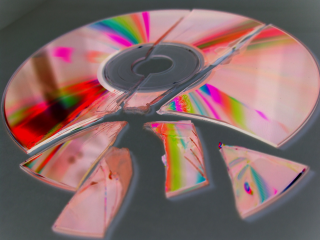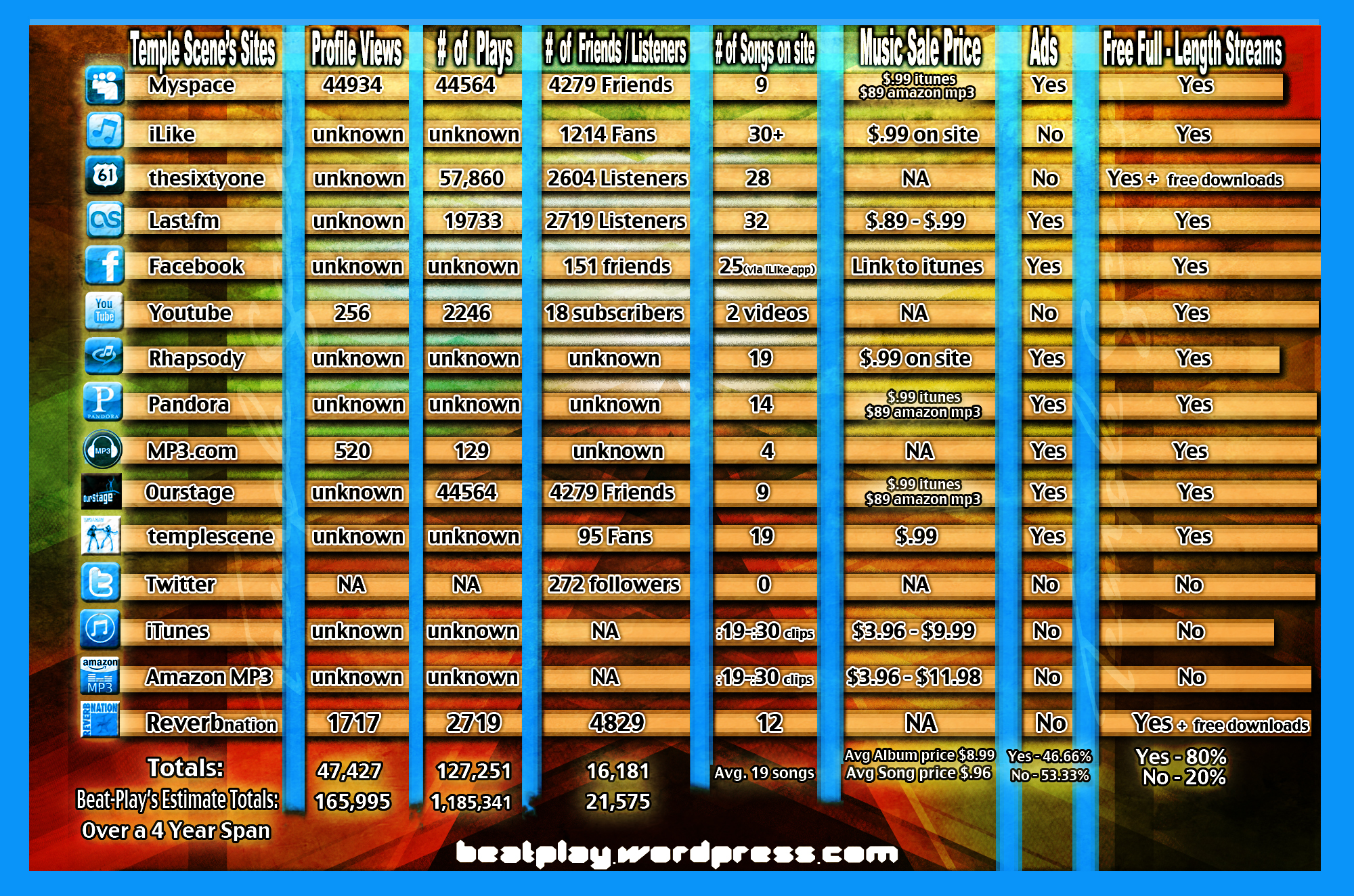
Music is so spread out online these days. Why? And why do artists not get paid for all the free plays they give away on these websites? These are two huge questions that I’ve been studying, and the answers are well worth addressing.
Part of music being so spread out has to do with the fact that the internet is still fragmented itself. The web is still set up like our real world - you have “sites” with their own “addresses” and you have to physically go to them. This is part of the problem for sure, and it turns out that it is actually easily solvable. With the software, you can pretty much make up your own rules, which means you could make everything just come to the user instead, almost like the iphone model, where every app is in one spot waiting for you at all times. That’s another topic though.
The rest of the problem really seems to be about preference. There are hundreds of music sites out there, and certain fans, or fan-bases, like to stick to certain ones for certain reasons. It could be the difference in interfaces or the difference in people in the network, but it usually has to do with simple preference.
The truth is that not one of the music sites out there right now has established supreme dominance over any other one. That means that as an artist, even though it is way more time consuming, it may actually seem smarter to be on 10 different websites rather than only one or two. After all, the way it is right now, you’ve gotta go where your fans are.
Some people may argue that having so many touch points out there can be beneficial for artist promotion; that a fragmented strategy on a fragmented internet is the best way to get your stuff out there; but they would be wrong.
Not only does the fact that there are hundreds of music websites out there make it harder for artists, in terms of managing the content, and harder for the fans, in terms of finding the music, but it also spreads out the fan bases so that they’re harder to reach, and harder to track.
The reason for one sole music community though, is not only about ease, for the artists and the fans, but it’s about concentration and stability. With 10 different websites you have 10 different methods of operation, 10 different user experiences, 10 different pricing models, 10 different ad models, 10 different terms of use..and so on. It can turn into a nightmare quick.
Everybody runs their site differently, and that can also mean different returns for the same content. If there could be only one website for music, where artists were satisfied with revenue returns, player features, the fan base size, the ad model and so on, it would open the doors up to do so much more with the artist’s online fan bases.
So it’s important that artists get their fans to come to one website for their music. Again, not only does this make it easier to reach them, but it makes it easier to track them and their streams of the music. As an artist right now, it’s definitely an important thing to think about.
It’s ideal to concentrate your fans as much as possible, because that way you can get your views, plays and fan numbers growing on one site. If you can concentrate all of these numbers to one spot, you might be considered worth more to potential advertisers and maybe you could start making some money by people just listening to free streams of your music, or just glancing at your profile page.
It’s time independent artists started thinking about how to realistically start earning revenue from their music online, and with the incredible viral quality of online content, and music especially becoming more and more popular to share, it’s time to start thinking seriously about ad models, and how to connect them in the right ways to the free content we already give away.
People don’t really buy independent music on iTunes, because on iTunes there’s no way to find something you’ve never heard of before. There’s no good recommendation for fans, which is exactly what independent artists need to get their stuff out there. Of course even if they get known, there can be piracy. This is why it’s best just to give away free streams that you can track and then collect ad revenue from. In the end, the ad model seems like the right answer if it’s done right.
Let’s take a look at a chart I put together, representing the online presence of one of my favorite indie bands - Temple Scene. On the left, I listed all (15) of the sites that Temple Scene has a presence on (there’s probably more). Along the top are different statistics and properties of those websites, relevant to the artist, such as number of plays, number of fans, amount of music offered, and so on.
Note: I will try to get Temple Scene to help fill in some of these numbers, and I would encourage you as an artist to make a similar chart. I would love to see the results of yours!

You will see that even though there are some large chunks of data missing, the band has recorded over 45,000 views to their profile pages. Using the data in the table to create an average, we can estimate that Temple Scene has accumulated something like 200,000 views overall, but even that I think, is a low estimate.
Over 200,000 views in 4 years - That’s about 50,000 a year. I bet the artists could negotiate some kind of long term ad revenue contract between them and a particular company for views like that, with a simple negotiation like for every view I get, I’ll show your ad once. Now imagine if the artist could get payed based on plays instead of views. These numbers were way bigger, with a total of 127,251 known plays.
One thing I need to note is that the 57,860 plays recorded on thesixtyone.com, actually technically isn’t plays, it’s hearts, which if you’re familiar with thesixtyone, are way less common than plays, yet are still dependent on them. I estimate, based on averages of Temple Scene’s fan base’s average plays/per heart, it would put the plays at just over a million on thesixtyone alone!
Of course there’s no way to actually track that exactly, because thesixtyone doesn’t choose to give you that information, but at the very least, this band has served well over 200,000 free streams of their music for sure, (though it could be more like 1 million) and they haven’t gotten payed for any of it!!
The real problem though is that the totals of these numbers are all spread out throughout 15 different websites, and so the opportunity to even use these numbers to negotiate with a sponsor is almost non-existant, being that most websites probably wouldn’t even let you place your own ads, and all of them would have different policies.
Also, I believe the fact that they are spread out like this means that these numbers are not as high as they could be. I mean think about it, if there was one website for all things music, and all of the fans in the world, or even the country were on that site, there would be a much better chance that those fans would run into your music, being already within close reach.
The way it is now, with the fans spread out all over the place, even if you’re on 15+ different websites like Temple Scene, you still won’t be covering all of the fans out there, and so the numbers will not be as high, even when added together. We need one music environment where the artists can take advantage of basically 1 huge fan base.
It turns out, this kind of situation would be better for the fans as well, because then all the music would be right there in one place too, and it could actually be brought right to them, using new forms of social recommendation. Did you like the song you just heard? What’d you think about that show last night? Did you leave a good comment on a band’s song today? This is all information that could potentially fuel a pretty useful recommendation for anyone who trusts your taste in music.
Imagine this kind of recommendation being tied to an ad model that pays artists based on how many plays they get. For each different song, there is a different unobtrusive and relevant ad. The songs just keep playing without the fans even having to search for anything, much like Pandora, except the songs are being filtered through their social networks instead of a broad algorithm.
If the music is good, it will get passed on through the social networks, and if a song gets played, the artist gets paid. The music can be free, easy to find, easy to manage, and easy to track. The artists can get free promotion and distribution, AND get paid, and everyone can be happy. The point is that this place can exist, and that this place already should exist!
We are working hard on bringing these concepts to reality. We’re currently in beta testing phases now. We need indie artists and music to start testing our social radio recommendation system now! If you would like to get involved please go here.
—
Dante Cullari is Founder & CEO Beat-Play, LLC.